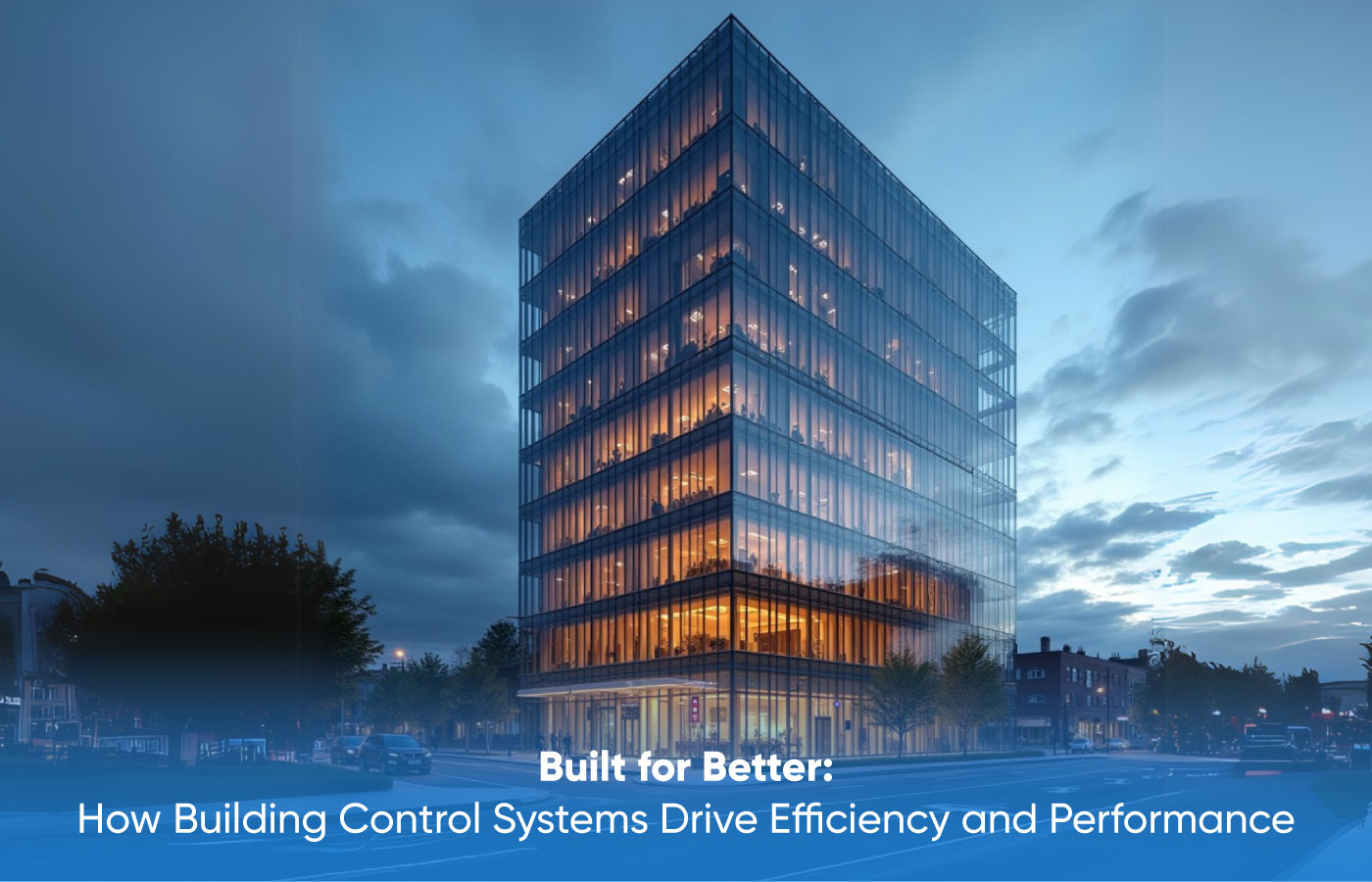Built for Better: How Building Control Systems Drive Efficiency and Performance

Introduction
Doors open, individuals enter, and spaces modify without a single manual command. Behind the scenes, a seamlessly connected network of sensors and intelligent systems continuously calibrates lighting, temperature, and airflow to meet real-time needs.
A Building Control System is the intelligence behind modern buildings, making them responsive, efficient, and synchronized. It goes beyond automation, orchestrating comfort, safety, energy use, and maintenance into a unified, seamless experience.
A building control system is beneficial and indispensable in modern workspaces where sustainability and flexibility are paramount. The quiet power makes everything work as it should, giving people and companies the power to operate smoothly and efficiently.
What is a Building Control System?
A Building Control System or Integrated Building Management System (iBMS) is an integrated platform to view, control, and optimize the performance of the building. Lighting, heating, ventilation, air conditioning (HVAC), Energy Management System(EMS), and security are some must-have services. It gives a bird’s-eye view and a dashboard full of usable information, automatic responses, and the ability to make intelligent decisions.
IoT Integration: The Intelligent Pulse of a Building
Sensors installed throughout the building detect movement, heat, air quality, occupancy, and other environmental factors, translating each into a data point entered into a centralized Building Management System (BMS). Ongoing real-time information enables the system to make adjustments, such as automatically shutting off lights in the presence of abundant natural light or improving airflow when levels of carbon dioxide rise. The outcome is a building that not only reacts but adapts to its environment to provide maximum comfort, efficiency, and performance at all times.

Predictive Maintenance:
Traditionally, building equipment is repaired on a time basis or the occurrence of failure, commonly causing unplanned downtime and repair at high expense. Predictive maintenance reverses this practice by allowing the building to indicate the exact time for attention before it fails. An example would be a building management system (BMS) that detects an elevator’s usage by analyzing sensor readings and monitoring how many cycles it has gone through. Once it goes beyond a set threshold, the system will automatically initiate a maintenance alert. Guesswork is avoided, and the risk of sudden emergency outages is minimized. Predictive maintenance minimizes downtime and increases equipment lifespan, saving time, resources, and money in the long run.
Energy Efficiency:
Energy is not just an expense; it’s a footprint. And in a planet moving toward sustainability, conserving energy is no longer a choice; it’s mandatory. A building control system becomes the key to smartly handling energy. It detects when rooms are vacant and dims lights or cycles HVAC systems down accordingly. It identifies major usage patterns and adapts to use energy optimally without waste.
A By integrating across various subsystems, the IoT BMS enables holistic energy efficiency, cutting unnecessary consumption while ensuring comfort and productivity.
Seamless Communication with Standard Protocols
Devices and sensors in a building speak different languages depending on who the manufacturer is and how they operate. Protocols like RS 485, Modbus, and BACnet are used to be harmonious. These interpreters allow systems with different manufacturers to join, share information, and communicate freely. This interoperability is the backbone for buildings that expand as time goes on and include disparate technologies.
Cloud Integration:
One of the game-changers in today’s building control ecosystem is cloud integration. Whereas conventional on-premise systems restrict access to physical sites, cloud-based BMS platforms shatter that restriction. Facility managers can control and monitor systems from any point, anywhere in the world. Real-time alerts, system status reports, and energy reports are as near as the fingertips. Additionally, cloud solutions provide data storage and historical analysis, assisting organizations in making strategic decisions based on trends, not snapshots.

Scalability and Global Integration:
Multiple properties can be managed on one dashboard, providing centralized command and control with localized customization. Whether it is a head office in Bangalore or a satellite office in Berlin, facility managers get to see and control everything without needing to be on the ground. Global integration provides for standardized operations, improved compliance, and optimized resource use.
Bridging the Integration Divide in Commercial Buildings
The future of real estate is digital, yet most buildings remain analog at their core. According to recent insights, 90% of buildings lack integrated management systems, while 10% run on outdated, layered systems labeled “Spaghetti Architecture.” This term refers to the tangled, non-interoperable setup of standalone systems that hinder efficiency and scalability.
In such environments, critical systems, from HVAC and lighting to fire safety and surveillance, function in isolation. This results in energy wastage, missed alerts, limited automation, and complex troubleshooting.
A centralized Building Control System rewires this paradigm by offering seamless integration across core infrastructure layers, including:
1. Fire Detection, Smoke Alarms, and Safety Systems
2. HVAC and Mechanical Operations
3. Video Surveillance and Digital Monitoring
4. Light Management and Energy Optimization
5. Intrusion Detection and Access Control
6. Water Supply and Usage Monitoring
7. Indoor Environmental Quality
8. Maintenance Scheduling and Service Requests
9. Enterprise Integration Across Facilities
This converged strategy enables systems to collaborate, share information, automate responses, and offer a single command center for facility managers. It’s the link that brings legacy infrastructure into intelligent, future-proof operations.
Conclusion
At Aastro Tech, we believe a smart building is more than just its structure, it’s a dynamic, adaptive environment that learns and evolves in real-time. Our Building Control Systems transform traditional facilities into intelligent ecosystems where HVAC, lighting, energy, and security systems work in seamless harmony. This level of integration empowers facilities management teams with predictive maintenance, centralized oversight, and operational flexibility. In today’s landscape, where efficiency, sustainability, and occupant comfort are essential, this intelligence isn’t just a value-add; it’s the new standard for modern workspace management.
Connect with AastroTech to discover how our smart facilities management solutions can elevate your building’s performance.
FAQs:
1. What is a Building Management System (BMS)?
A Building Control System is a single, central gateway that oversees and controls building activities such as HVAC, lighting, energy consumption, security, and maintenance, which enables buildings to function at their best.
2. What can IoT do to improve a Building Control System?
IoT integration allows sensors to receive real-time feedback on temperature, occupancy, air quality, and other factors. Hence, it will enable the BMS to respond intelligently and automatically regulate comfort and efficiency levels accordingly.
3. What is predictive maintenance in BMS?
Predictive maintenance applies sensor information to predict equipment problems. For instance, a BMS can monitor elevator usage and plan maintenance in advance, cutting down on breakdowns and downtime.
4. Can a BMS reduce energy bills?
Yes. A BMS avoids energy wastage and reduces operation costs by dynamically varying lighting, Smart HVAC, and equipment loads according to current occupancy and usage.
5. Is it possible for many buildings in locations to be operated by a single BMS?
Yes. One BMS can control several buildings within cities or countries thanks to cloud scalability, with localized customization and central control.
